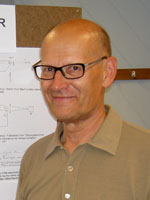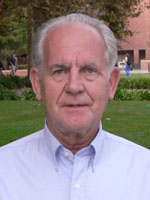
W. Gerhard Pohl
Austrian Chemical Society

Karlheinz Schwarz
Technical University of Vienna
Transatlantic Science
W. Gerhard Pohl
In January 1992 I read about the first Science Education Gordon Research Conference, scheduled for 30 March through 3 April 1992 in Ventura, California. The main reason I applied to participate was because Linus Pauling was the first speaker. I quickly received a letter informing me that approximately ninety people were on the waiting list in front of me. There was no chance I would be admitted.
However, I had included in my application a list of all my activities in the field of science education. As a result I was asked to submit a proposal to offer a similar Gordon Conference in Europe. My proposal for a conference titled New Visualization Technologies for Science Education was accepted in March 1993. To get acquainted with the Gordon Conferences I was invited to participate in the Innovations in the Teaching of College Chemistry Gordon Conference held in Oxnard, California, in January 1994. There I learned a lot about the organization.
John Fackler of Texas A&M University acted as my cochair for the Science Education Conference in Irsee, Germany, and I appreciated his help. In a session called “Visualization of Molecules and Atoms” two Nobel laureates gave lectures: Gerd Binning showed us how solid surfaces can be visualized atom by atom using atomic force microscopy, and Robert Huber discussed the indirect visualization of large molecules by X-ray scattering. Other speakers at the conference talked about electron microscopy and computer graphics as methods to reveal molecular structures and establish structure-function relationships. Ways to use interactive media at science museums were presented by speakers from Cité des Sciences et de l’Industrie in the Parc de la Villette (Paris) and the Deutsches Museum (Munich). Wolfgang M. Heckl, now general director of the Deutsches Museum, showed an impressive film taken with a scanning tunneling microscope of the removal of an atom from a surface layer. Peter Atkins, a chemistry book author, and Ernst Peter Fischer, now a well-known German book author, talked about writing in science.
The significance of the visualization of molecules has grown since 1994. Various macromolecules are visualized based on X-ray data using computer graphics; a good example is the visualization of a potassium channel of mammalian cell membranes published in
Science by Roderick MacKinnon’s group. Visualization has become a major theme of science education. The Visualization in Science and Education Gordon Conference held at Queen’s College in Oxford, England, in 2005 was well attended. Visualization is not only an enormous help for researchers in establishing structure-function relations, but it also allows science educators to explain complex chemical and biological phenomena at a secondary level. Physical molecular models are useful for teaching introductory chemistry, whereas computational graphics are indispensable when dealing with large assemblies of molecules and macromolecules. Progress in the field of visualization techniques continually shows at the Gordon Conference.
Karlheinz Schwarz
In 1994 I chaired a Gordon Research Conference called Phase Transitions in Non-Metallic Solids, which was held at the medieval village of Volterra in the Tuscany region of Italy. It was begun to bring together experts from physics, chemistry, mineralogy, crystallography, mathematics, and materials sciences. In retrospect, the unusual setting has created a very positive atmosphere for fruitful discussions that started many collaborations in this field. For example, one of the speakers, J. Manu Perez-Mato, from Bilbao, Spain, spent a year on sabbatical with my group in Vienna; we have several joint publications that were the result of his expertise in group theory and our competence in first principles calculations.
The second GRC I organized in Europe was called Electron Distribution and Chemical Bonding, held at Queen’s College in Oxford in 1998. This conference has occurred triennially for the past thirty years. I have at-tended most of the meetings, and I must say that these conferences have had a significant impact in the field; it is the interdisciplinary nature of GRC that makes them so important. We brought together experimentalists and theorists–from researchers who focus on instrumentation like synchrotron radiation or area detectors to computational scientists who simulate the properties the experimentalists measure. The combination of the various approaches has led to new insight and brought progress to science.
Several factors make the Gordon Conferences unique. Limiting the number of participants allows time for intensive discussion on unpublished research. The mix of experts from various disciplines–both senior and young scientists–creates an atmosphere in which problems can be openly discussed and constructive criticism can occur. The conference locations are usually far from large cities but are attractive and allow a focus on research without too much distraction. The mandatory requirement that afternoons be kept free from lectures is conducive to informal and fruitful conversation. Afternoon excursions in the surrounding area have led to long-lasting friendships and collaborations. Both Gerhard Pohl and I have seen many joint publications initiated by friend-ships created at GRC. Finally, alternating conference sites between the United States and Europe has helped streng-then understanding and transatlantic relations among scientists.